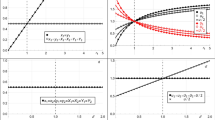Summary
In the present paper we explore the set of equilibria in a game-theoretic model in which players can jointly exploit a productive asset. As in repeated games, we find that under certain circumstances there may be efficient as well as inefficient equilibria. In the model we study, efficient trigger-strategy equilibria may exist from some starting states (stocks of assets) but not others. More precisely, there is a stock level, sayy′, such that an efficient trigger-strategy equilibrium exists from starting stocks greater than or equal toy′, but not from those strictly less thany′. (This statement is meant to include the cases in whichy′ is zero or infinite.) Under some circumstances, there may exist a new kind of equilibrium, which we call aswitching equilibrium. We show that, in our model, whenever y′ is positive (and finite), there is an open intervalI with upper endpoint y′ such that, from any starting stock inI there is an equilibrium of the dynamic game with the following structure: the players follow an inefficient but growing path until the stock reaches the levely′, and then follow an (efficient) trigger strategy after that. The use of a continuous-time model enables us to conveniently decouple the delay of information from the time interval between decisions.
Similar content being viewed by others
References
Ausubel, L.M., Deneckere, R.J.: One is almost enough for monopoly. Rand. J. Econ.18, 255–274 (1987)
Benhabib, J., Ferri, G.: Bargaining and the evolution of cooperation in a dynamic game. Econ. Lett.24, 107–111 (1987)
Cave, J.: Long-term competition in a dynamic game: the cold fish-war. Rand. J. Econ.18, 596–610 (1987)
Dutta, P.K., Sundaram, P.K.: The tragedy of the commons? A characterization of stationary perfect equilibrium in dynamic games. University of Rochester, working paper no. 172, 1989
Dunford, N., Schwartz, J.T.: Linear operators. Part I. New York: Interscience 1958
Ekeland, I., Turnbull, T.: Infinite-dimensional optimization and convexity. Chicago London: University of Chicago Press (1983)
Friedman, A.: Differential games. New York: Wiley-Interscience 1971
Fudenberg, D., Tirole, J.: Capital as a commitment: strategic investment to deter mobility. J. Econ. Theory31, 227–250 (1983)
Haurie, A., Tolwinski, B.: Acceptance equilibria in dynamic bargaining games. Large Scale Syst.6, 73–89 (1984)
Hämäläinen, R.P., Haurie, A., Kaitala, V.: Equilibria and threats in a fishery management game. Optim. Control Appl. Methods6, 315–333 (1985)
Kaitala, V.: Game theory models of fisheries management — a survey. In: Basar, T. (ed.) Dynamic games and applications in economics, pp. 252–256. Berlin Heidelberg New York: Springer 1986
Kamien, M.I. Schwartz, N.L.: Dynamic optimization: the calculus of variations and optimal control theory in economics and management. New York Oxford: North Holland 1981
Krasovskii, N.N., Subbotin, A.I.: Game theoretical control problems. Berlin Heidelberg New York: Springer 1988
Lancaster, K.: The dynamic inefficiency of capitalism. J. Polit, Econ.81, 1098–1109 (1973)
Levhari, D., Mirman, L.J.: The great fish-war: an example using the Cournot-Nash solution. Bell. J. Econ.11, 322–334 (1980)
Maitra, A., Parthasarathy, T.: On stochastic games. J. Optim. Theory Appl.5, 289–300 (1970)
Maitra, A., Parthasarathy, T.: On stochastic games II. J. Optim. Theory Appl.7, 154–160 (1971)
Majumdar, K.M., Sundaram, R.K.: Symmetric stochastic games of resource extraction: the existence of non-randomized stationary equilibrium. In: Raghavan. T.E.S. et al. (eds.) Stochastic games and related topics, pp. 175–190. Netherlands: Kluwer Academic 1991
Oudiz, G., Sachs, J.: International policy coordination in dynamic macroeconomic models. NBER working paper 1417, 1986
Pohjola, M.: Applications of dynamic game theory to macroeconomics. In: Basar, T. (ed.) Dynamic games and applications in economics, pp. 103–133. Berlin Heidelberg New York: Springer 1986
Pontryagin, L.S., Boltyanskii, V.G., Gamkrelidze, R.V., Mischenko, E.F.: The mathematical theory of optimal processes. New York: Wiley 1962
Radner, R.: Dynamic programming of economic growth. In: Malinvaud, E., Bacharach, M.O.L. (eds.) Activity analysis in the theory of growth and planning, pp. 111–141. London: MacMillan 1967
Reynolds, S.: Strategic investment with capacity adjustment costs. Tuscon, University of Arizona, (unpublished) 1988
Rustichini, A.: Second best equilibria for games of joint exploitation of a productive asset. Econ. Theory2, 191–196 (1992)
Simon, L.K., Stinchcombe, M.B.: Extensive form games in continuous time: pure strategies. Econometrica57, 1171–1214 (1989)
Sundaram, R.K.: Perfect equilibria in non-randomized strategies in a class of symmetric games. J. Econ. Theory47, 153–177 (1989)
Tolwinski, B., Haurie, A., Leitmann, G.: Cooperative equilibria in differential games. J. Math. Anal. Appl.119, 182–202(1986)
Tolwinski, B.: A concept of cooperative equilibrium for dynamic games. Automatica18, 431–447 (1982)
Author information
Authors and Affiliations
Additional information
We thank the C. V. Starr Center at New York University for research support. The views expressed here are those of the authors, and not necessarily those of AT&T Bell Laboratories.
Rights and permissions
About this article
Cite this article
Benhabib, J., Radner, R. The joint exploitation of a productive asset: a game-theoretic approach. Econ Theory 2, 155–190 (1992). https://doi.org/10.1007/BF01211438
Received:
Revised:
Issue Date:
DOI: https://doi.org/10.1007/BF01211438



